Chapter 1 Scallop broodstock: facilities, reproduction and spawning
1.1 CULTURE FACILITIES
The model hatchery custom-built for rearing of subtropical and tropical scallop species at the Bermuda Biological Station for Research Inc. (BBSR), is shown in great detail in the technical drawings (labelled Pg 1-20). This was done in order to provide a clear understanding of the requirements for such a culture operation, and facilitate building of a similar facility; thus, details of equipment utilized, pipe diameter, valves, etc. is provided. Although this facility was built for rearing scallops, it is a flexible design making it easily adaptable to the culture of other bivalves, and even to that of certain gastropod species.
It is not the intent of this guide to dwell into the engineering of such a hatchery, but to provide enough information to allow replication of this modular facility and to facilitate its costing. There are publications available which provide a wealth of information on various engineering aspects such as materials selection, seawater flow control, heating and cooling, etc.; a recommended book for answers to such questions is that of Huguenin and Colt (2002).
In the described modular hatchery, all piping materials used were made of rigid polyvinyl chloride (PVC) schedule 40, unless otherwise specified. It is one of the most common materials used in seawater culturing systems; it is biologically acceptable, as it is resistant to seawater, has a smooth surface minimizing the burrowing or fouling by marine organisms in the seawater, and does not leach any toxic compound. Schedule 40 piping has thinner walls and is sufficient for a seawater system, such as the one described here. PVC can be joined by solvent or flanging. It has been found in Bermuda that it can be prone to cracking overtime, especially when exposed to sunlight and associated higher temperatures. PVC piping is readily available, easy to work with and relatively affordable. Care must be taken when costing out PVC materials, as fittings can be significant to the overall expenses.
The modular hatchery was built in Bermuda according to environmental laws of the country. Because of its size and its strict use for filter-feeding organisms (bivalves), effluent water was low in pollutants, and discharge was not considered an issue. However, any replication of this facility in another country must be adjusted to the regulations of the country. Please note that throughout the text, the terms “excess outflow” and “effluent” are used interchangeably.
The facility was designed to be flexible in its use, and of easy maintenance. For this reason, unions are used throughout the facility before and after valves or equipment to facilitate routine cleaning and replacement of parts when required. Cleanliness of the seawater supply is primordial in rearing of the early life stages, and procedures used for maintaining various parts of the seawater system are provided as appendixes or protocols throughout this guide.
Culture facilities of the described hatchery comprise:
1. A dedicated seawater system providing a continuous supply of filtered seawater. 2. A temperature control system for seawater in support of broodstock conditioning and requirements for larval and juvenile rearing.
3. 1 000 litres insulated, polyethylene tanks for standard larval rearing in closed systems.
4. Flexible usage 450 litres round tanks, and stacked raceways for setting pediveligers and growing spat. Raceways may be connected either as, a single open-flow, a semi recirculating system, two independent troughs, or holding tanks for a series of small, independent aquaria.
1.1.1 Master layout plan
Refer to Technical Drawing – page 1. The entire facility is comprised of a hatchery/ nursery/broodstock complex housed in two fiberglass insulated air-conditioned containers, a separate container for algal cultures, a heating unit housed in a wooden shed providing heated seawater to the hatchery/nursery facility, and an exterior tank system providing additional space for maintenance of broodstock and spat. The pump unit located on the shoreline pumps in raw seawater and supplies the entire facility.
Technical drawing, Pg. 1
Master layout plan
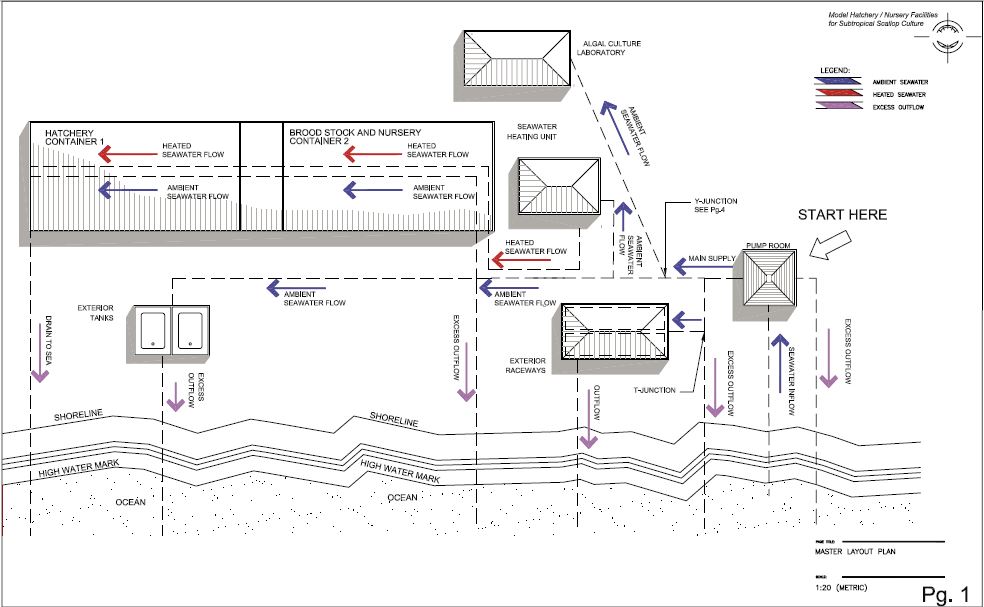
General seawater flow is shown, including main ambient supply, heated seawater supply, and outflow. For ease of understanding, these are colour coded blue for ambient seawater, red for heated and purple for outflow. This colour code remains the same for all the technical drawings. Raw seawater is pumped from a 5 m depth and supplied via a main line to the hatchery complex; this was the maximum depth from which it could be pumped at this location, and is not a guideline for optimal pumping. Seawater is diverted from the main line to various pathways through T-junctions and regulated by one-way ball valves. Branching off from the main line, are supply lines to the exterior raceways, the heating unit, a Y-junction to the algal culture container, to the hatchery complex, and finally to the exterior holding tanks. A number of pathways are provided to allow excess water to flow out of the system back to sea; the first is found at the pump room. (Note: Throughout most of the operation, seawater supply exceeds the demand and excess water pumped in is sent to drain). Other outflow pathways are provided for the exterior raceway system, the hatchery complex, and the exterior tanks. These pathways also enable the regulation of water flow to various tanks, by altering the volume of water retained within the supply lines.
All tank systems receive ambient seawater from the pump room. The hatchery complex also receives temperature-controlled seawater from the heating unit via a second pipeline.
1.1.2 Seawater supply
The seawater system includes a primary pumping system with a main intake line (see technical drawing – page 2), a secondary pump linked to the main intake line (see technical drawing – page 3), and a secondary pumping system with a second smaller intake line linked to the secondary pump (see technical drawing – page 3). The pump house is housed within a 4 m2 stone building with ventilation and a cement floor.
1.1.2.1 Primary seawater supply
Refer to Technical Drawing – page 2. The main seawater intake is located at approximately 5 m depth. A 100 mm pipe is maintained in place by a 1 m high concrete anchor (1 m2 base, tapering to 0.1 m2 at top) (see technical drawing photo – 1/Pg2). The seawater intake is therefore approximately 1 m off the sea bottom; in areas where depth is greater, it is recommended to install the intake higher above the sea surface to avoid additional re-suspended sediments. A plastic roof drain is screwed into the end of the intake to prevent large objects and animals from being sucked in. In order to further ensure that the seawater pipe remains unclogged, a screen, made of 25 mm mesh, is tied with plastic cable around the intake. This mesh is changed once a year, prior to the beginning of the hatchery season.
The 100 mm intake line is weighted above the sea bottom with concrete blocks bridging the pipe. It is made up of 6.5 m pipe lengths glued together. Flange connections located every 30 m allow for dismantling of the pipe in case of blockages. Diagram 2/Pg2 (see technical drawing – page 2) shows details of the intake at the low tide mark, prior to connection to the pump in the pump house. The 100 mm pipe is reduced to a 50 mm diameter pipe, where a 50 mm clear check valve is installed to stop any loss of water in the pump in the event of a power blackout. Unions on either side of the check valve, allow for routine cleaning or changing of the valve. A flexible 50 mm pipe leads to a 50 mm flange for connection to the pump.
As seen in Diagram 3/Pg2 (see technical drawing – page 2), in the pump house, a 50 mm to 40 mm bushing reduces the diameter of the intake, to fit a 40 mm union connecting to the main pump. Seawater is pumped continuously at a flow of about 200 litres per minute from the primary centrifugal pump (Sweetwater PS-6 2 hp). Pumped water
Technical drawing, Pg. 2
Primary seawater supply
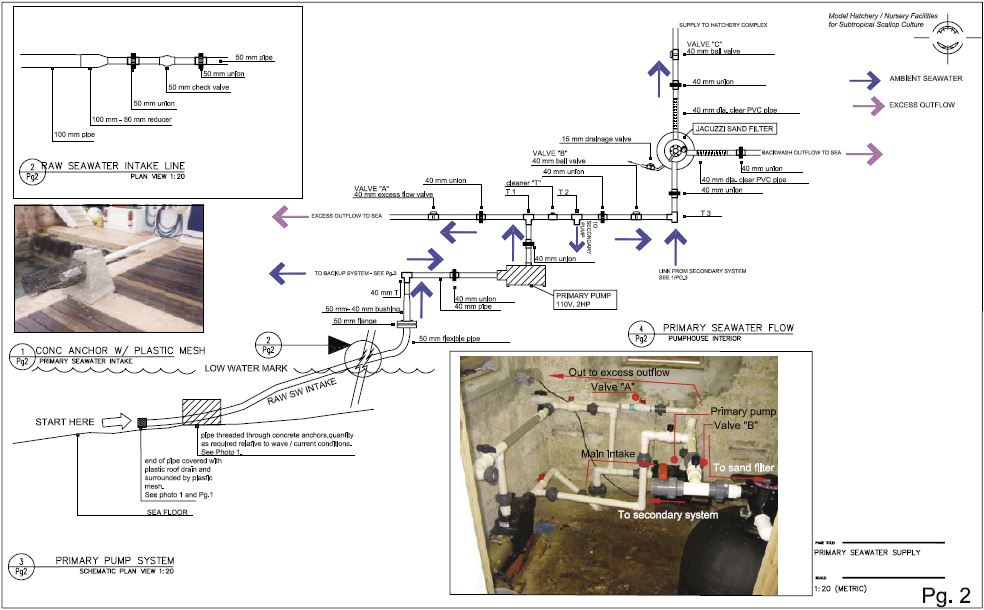
is passed through the first T-junction (T1) diverting the water either through the effluent (excess outflow) pipe to the sea, or towards the sand filter (Jacuzzi Sand Filter JF4) for removal of coarse material. A cleaner T fitting (T connection with threaded cap) provides the ability to clean the entire pipe system on a routine basis, by adding chlorine. A second T-junction (T2) links this main intake system to the secondary pump. Direction of flow is regulated by one-way ball valves (Valve B to sand filter, Valve A to excess flow). Unions installed before valves facilitate replacement and maintenance of system. Prior to the sand filter, a third T-junction (T3) links the secondary pump to the sand filter. Photo 4/Pg2 illustrates the system described.
The sand filter is set up for daily backwash; Appendix 6 provides detailed backwash procedure conducted every morning prior to any other routine operations, along with a sample check sheet. A 40 mm clear pipe aids in monitoring the clarity of the water supplied to the hatchery complex. Seawater supply from the sand filter to the hatchery complex is monitored by a one-way ball valve (Valve C) (see technical drawing – 2/Pg3).
The entire seawater pumping system, including the sub-surface pipeline is cleaned once a year, at the end of the hatchery/nursery season, in order to control marine biofouling. Some sites may have higher biofouling rates and may require more frequent cleaning. Huguenin and Colt (2002) outline various methods for controlling biofouling. The procedure used at the Bermuda hatchery is outlined in Appendix 5. At this time, complete drainage of the sand filter is done, and usually new sand is purchased for the following season. Cleaning of all parts, including the pipeline is done in Bermuda using commercially available chlorine (or bleach). The use of “pigs” is being considered; these are contractible bullet-shaped plastic parts, which are launched through a clean out and pushed though the piping under pressure (<100 psi). These “pigs” clean the pipes by friction.
1.1.2.2 Secondary seawater supply – link to main intake line
Refer to Technical Drawing – page 3. In the event of a primary pump failure, the secondary pump may be utilized for supplying seawater to the hatchery complex by pumping water from the main intake line. As seen in Diagram 1/Pg3, this can be done by diverting water from T2 toward the secondary pump (Hayward self-priming centrifugal pump 1.5 hp), by opening Valve C and closing Valve B going through junction T4 (T4 allows the inflow of water to come from the main intake line or from the secondary line, see paragraph below). After passing through the secondary pump, water is passed through junction T5, and links either to the sand filter for supply to the hatchery complex, or to the excess outflow pipe. As a further option, junction T6 also provides a more direct route from the main intake line to the secondary pump, bypassing the primary pump. The pumped water then flows back towards the sand filter via T4. Photo 3/Pg3 illustrates the seawater flow for the secondary system.
1.1.2.3 Secondary seawater supply – link to secondary intake line
Refer to Technical Drawing – page 3. A 50 mm line pumping water from a 1.5 m depth is installed as a secondary line; again this was the maximum depth of this location and is not a guide for optimal pumping depth. Ideally, the secondary line should parallel the main intake line. This was not possible in this case; hence a smaller line was set up in the event of clogging or other emergency rendering the use of the main intake line difficult. In practicality, during four years of operation, this line was used only to facilitate priming of the main pump; nonetheless, it is advised to have a back-up system.
This secondary intake line is connected to the secondary pump through a 40 mm pipe (Diagram 1/Pg3 and Photo 3/Pg3). At T4, water is directed towards the secondary
Technical drawing, Pg. 3
Secondary seawater supply
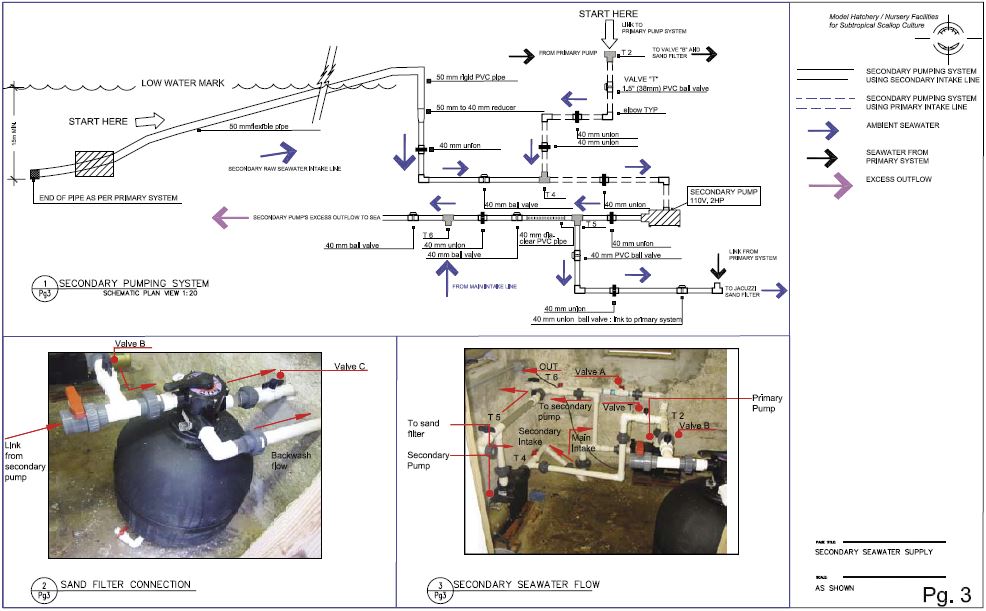
8 Installation and operation of a modular bivalve hatchery
pump, flows through junction T5 and passed through the sand filter for supply. Any excess water is returned to sea through the excess outflow pipe connected at T5.
1.1.2.4 Main seawater supply to hatchery complex
Refer to Technical Drawing – page 4. The plan view on Diagram 1/Pg4 shows the main supply line to the entire facility via a 50 mm pipe, starting at the pump house and fixed alongside a land path leading to the complex. The supply line is made up of 6.5 m lengths segments connected using 50 mm straight, 45 °, or flexible rubber couplings, depending on the terrain. Drain valves are at low points in the supply line to ensure complete drainage of the line during cleaning. A clean-out Y-junction is installed at the beginning of the line after the sand filter, for chlorination purposes (see Appendix 5). All seawater passing through the main supply line is coarsely filtered through the sand filter, and is at ambient temperature. Any further filtration or temperature control of the seawater is conducted at specific points in the system when needed.
For ease of reading, water lines are colour coded – ambient supply lines in blue, and effluent (or excess outflow) in purple. At junction T7 sand filtered seawater is diverted to the outdoor raceway. This secondary line is also used for draining the entire line; for this reason, a one-way ball valve is installed immediately after T7, followed by a T-junction providing direct flow to the exterior raceway. One-way ball valves on either side of the T-junction control the flow rate. Excess seawater is sent to sea through the excess outflow pipe line.
Returning to the main supply line, the second main junction is a Y-junction providing seawater to the algal container. In this case, the algal container is located uphill of the hatchery complex. This provides a future option to gravity feed algae to the broodstock and spat. This option is not shown here. Seawater supply to the algal container is regulated by Valve Y. The Y-junction reduces the 50 mm supply line to a 40 mm line and connects to a typical filtration system installed on the exterior wall of the algal container. Note: Details of the filtration system are provided in 1/Pg5A (see technical drawing – page 5A). Algal supply line is drained by gravity through a reduced 25 mm pipe, and controlled by Valve Z. As this drain is used only following cleaning of the algal supply pipe, only chlorinated seawater or fresh water seep into the soil.
After the Y-connection, junction T8 on the main intake line, supplies coarsely filtered seawater to the heating unit for the temperature control necessary for larval rearing.
The distribution of seawater (both ambient and heated) to the hatchery complex and to the exterior tanks is shown in greater detail in the second diagram below (see technical drawing – 2/Pg 4). These junctions are located under the hatchery complex containers. Junction T9 provides ambient seawater to the exterior tanks; the flow of which is regulated by 50 mm one-way ball valves. Junction T10 is the last junction supplying ambient seawater to the hatchery complex, by a 50 mm pipe running alongside the wall of the container, and entering the complex at the top of the container, parallel to the ceiling. Flow to the hatchery is regulated inside the hatchery (see technical drawing Diagram – 1/Pg 8). The excess seawater is directed back to sea and regulated by 40 mm valve connected to T10.
1.1.3 Heating unit
Refer to Technical Drawings – pages 5A and 5B. Description of the heating unit is provided in technical drawing – page 5A; for ease of understanding, labelled photographs are given on technical drawing – page 5B. This heating unit is housed separately from the hatchery complex; mainly due to lack of space in the hatchery. A wooden shed of 2x2.6 m is used for this purpose (see Photo 1/Pg5B).
Technical drawing, Pg. 4
Primary seawater supply to hatchery complex
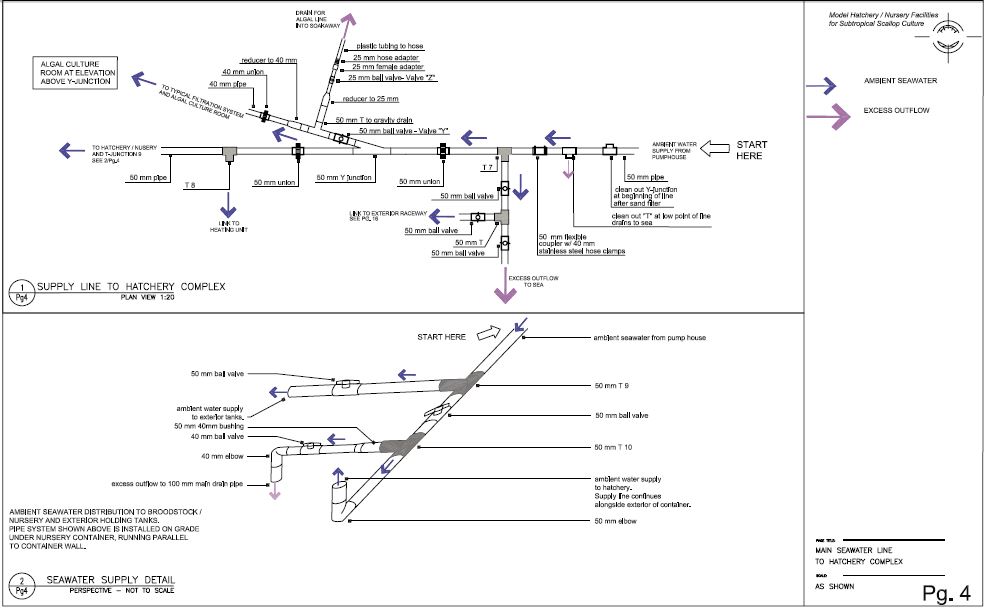
This unit consists of a square 1 000 litres tank, used for semi-recirculation of 1 µm filtered seawater; where, a continuous inflow of ambient seawater is heated and maintained at a set temperature through partial recirculation. Heated seawater is supplied to the hatchery on demand and is mainly required during water changes for larval rearing.
Ambient seawater, coarsely filtered by the sand filter, flows from the pump house through the 50 mm supply line (see technical drawing Diagram – 1/Pg5A). The line is reduced to 40 mm for connection to the filtration system, which is typical of that used throughout various points of the facility. A Hayward swimming pool filter (C250) removes coarser particles (to 25 µm). A 15 mm valve is fitted to the filter housing for cleaning and drainage after use. On the outflow side of the C250 filter, a reducer to 20 mm connected to two cartridge filters, 10 µm and 1 µm filters in that order. Unions before and after the coarse filter allow for replacement of parts and/or cleaning of the system when required. The inflow of 1 µm filtered seawater to the heating tank is done through a 20 mm pipe (Refer to Photo 3/Pg5B for illustration).
Within a 1 000 litres insulated BONAR tank are three titanium heaters (4 000 watts each) suspended so that maximum water level in the tank remains below the heads of the heaters. Each heater is connected to a digital temperature controller (one-phase), with an automatic function for turning the heater off when the desired temperature is reached. A water level alarm switch regulates the onset of the delivery pump; such that the switch closes contact and turns off the pump, when the water level drops (see Photo 2/Pg5B). This prevents the heaters from burning and the pump from running dry. The outflow is located at the base of the tank, and water flows through a 25 mm pipe; a 25 mm ball valve (Valve X) outside of the outlet controls the outflow of heated seawater. For delivery of heated seawater, Valve X is opened, distributing seawater through junction T11 prior to the pump. T11 allows for delivery of seawater to the pump when heated seawater is required or to outside drain via Valve F, when system is no longer in use. For heated seawater supply, flow is directed via T11 to a vertical delivery pump (Quiet One Centrifugal Pump), fitted with 20 mm adapters. (You may require yearly replacement of the pump and for this reason unions are fitted before and after the pump for ease of replacement). From the pump, the line is increased to 25 mm, and is passed through junction T12; this allows for partial recycling of the water to the heating tank (via Valve E), and for supply to the hatchery (via Valve D). In this way, water temperature is maintained constant through partial recirculation of heated water, and a continuous supply of heated seawater is available for spawning and larval rearing. Proper adjustment of valves D and E is critical to maintaining the balance between inflow of water-through the main supply and recycled pipe – and outflow to hatchery (refer to Photo 4/Pg5B).
A side view diagram of the tank indicates details of the overflow pipe (see technical drawing – 2/Pg5A). This is an additional security for preventing overflow of water over the sides of the tank, should the balance between inflow and outflow be disrupted. A 40 mm hole is drilled into the tank and fitted with a 40 mm pipe cemented into the tank, and reduced to 25 mm. A 100 mm standpipe is added to the top using a T-junction. The drain pipe from the overflow by-passes the heated outflow seawater pipe, and connects to a general drain pipe via T13.
Appendix 4 indicates the procedures used for setting up the heating unit, achieving the proper balance between inflow and outflow, and cleaning the system after use. Diagram 3/Pg5A (see technical drawing – page 5A) shows the heated seawater supply to the hatchery as it comes out of the heating shed, as well as the pathway for draining of the heated seawater system after use. The heating supply to hatchery is provided from
Technical drawing, Pg. 5A
Seawater heating unit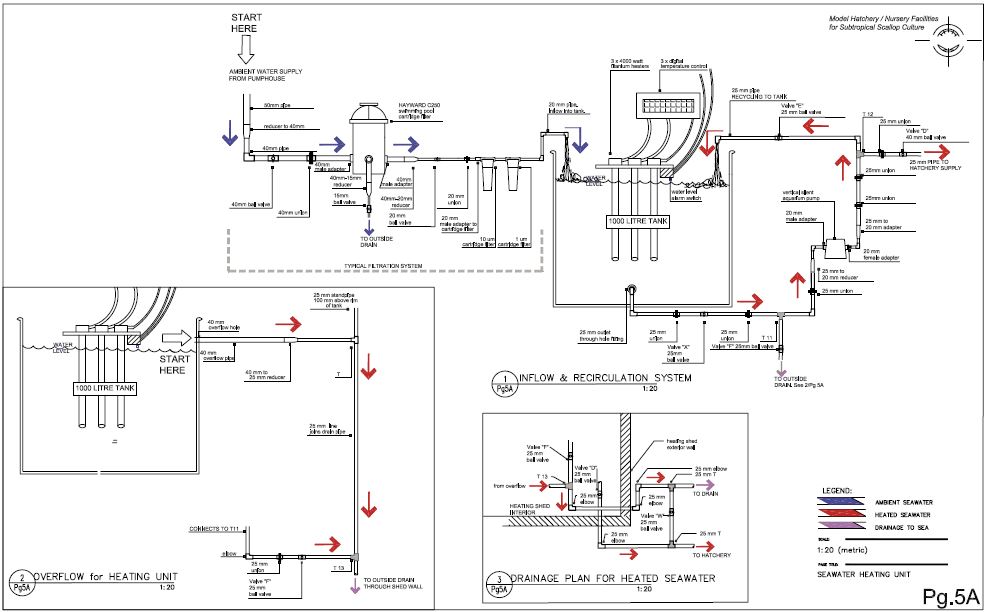
Technical drawing, Pg. 5B
Seawater heating unit: Photographs
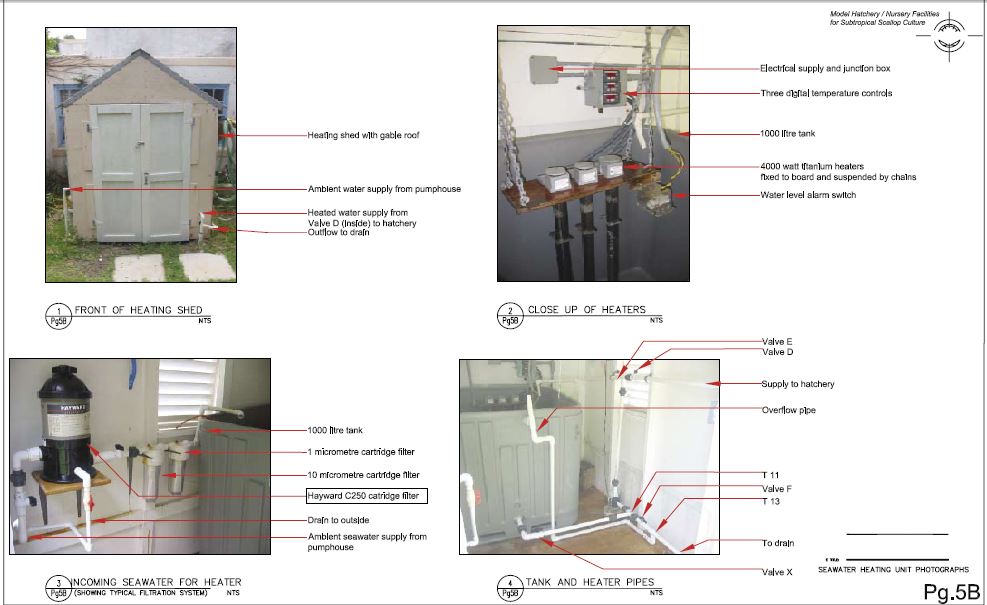
Valve D; in-line to the hatchery is a T-junction allowing for drainage of hatchery heated seawater line after use; this is regulated by a one-way ball Valve W, which opens into a main draining pipe. This main draining pipe also collects water from the overflow of the heating tank, and from the bottom outlet (regulated by Valves X and F) when emptying of the heating tank is needed. Pipes for supply to hatchery and drain are buried in the ground.
This heating system allows for an 8 °C heating differential. It takes approximately 2 hours to fill the heating tank, and obtain the desired temperature. This design allows for the continuous supply of heated water during spawning procedures for maintenance of broodstock and gamete solutions at desired temperature, and supplies 4 000 litres of heated seawater for larval rearing.
1.1.4 Hatchery/broodstock/nursery complex
Refer to Technical Drawings – page 6A, 6B and 7.
1.1.4.1 Container layout plan
Refer to Technical Drawing – page 6A. Two reefer containers (6.5x2.5 m) are linked together to create the hatchery complex, comprising facilities for broodstock holding and conditioning, larval rearing and post-larval rearing (see technical drawing – 1/Pg6A and 2/Pg6A). Each container is installed on a concrete slab poured for each corner of the container. Containers are installed on a 2 percent slope, decreasing from the centre to the end, allowing for ease of drainage, namely during water exchanges to larval tanks; this also facilitates spraying clean the floor with a jet of freshwater to remove any debris and maintain cleanliness. Any water or debris washes under the container door into the side open gulleys installed on the outside of the containers. The floors of the containers are ribbed aluminium facilitating routine maintenance. The internal walls of the container are of glass-fibre, allowing for climate control and enabling the drilling of holes for seawater pipe entry. A small hallway is created between the two containers, closed in by doors on either side; such that the complex could be entered from either side. Large container doors are left on the end of each container facilitating movement of tanks or large equipment in and out of the containers. The total surface area of the complex is 33 m2.
The container elevation diagram (see technical drawing – 1/Pg6A) also shows the two seawater supply lines, ambient and heated, running alongside the exterior wall of the containers, and entering the complex by an elbow through the wall parallel to the ceiling. The heated seawater line connects to the heating system drain via a T-junction for routine cleaning of the hatchery heated seawater line after use; drainage is controlled by Valve W as described on technical drawing – 3/Pg5.
1.1.4.2 Container plan diagram
Refer to Technical Drawings – pages 6A and 6B. The overall plan of the container complex is shown separately (see technical drawing – 2/Pg6A). Photos are given on Page 6B for clarity. The left container consists of the hatchery facility with four 1 000 litres insulated BONAR tanks (see technical drawing – 2/Pg6B). Shelving is installed in the right hand corner of the container for storage of sieves used during water change. Other equipment used for hatchery purposes, such as trays, hoses and brushes are hung on the side of the container wall on hooks. One air conditioning unit in the hatchery maintains adequate climate control. Further shelving space, located in the hallway, stores spat sieves and other small equipment.
The right container houses the broodstock tanks, saltwater table, bench space, and nursery tanks and raceways (see technical drawing – 1/Pg6B). The seawater supply
Technical drawing, Pg. 6A
Container layout plan
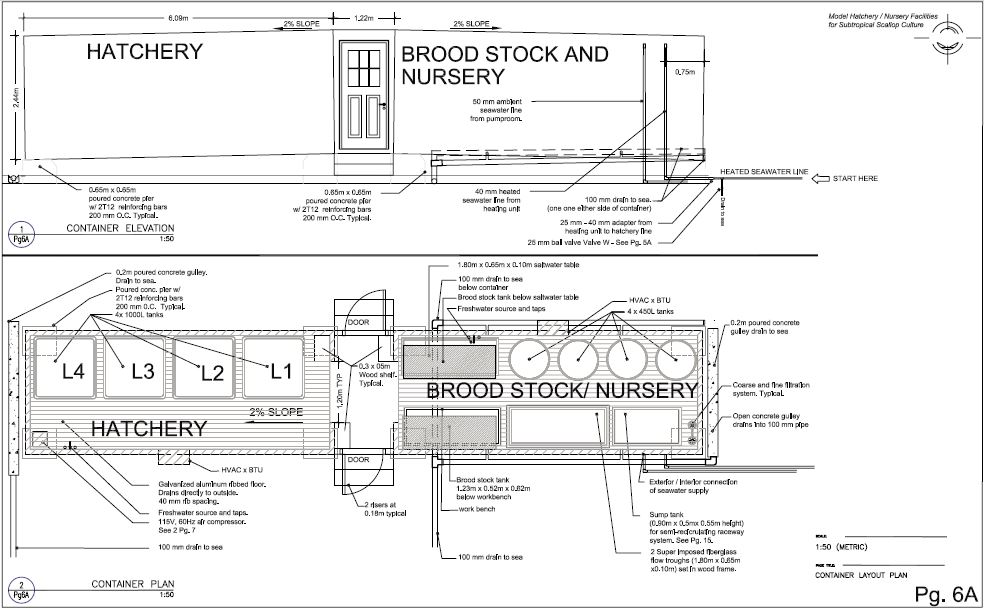
Technical drawing, Pg. 6B
Hatchery & nursery: Photographs
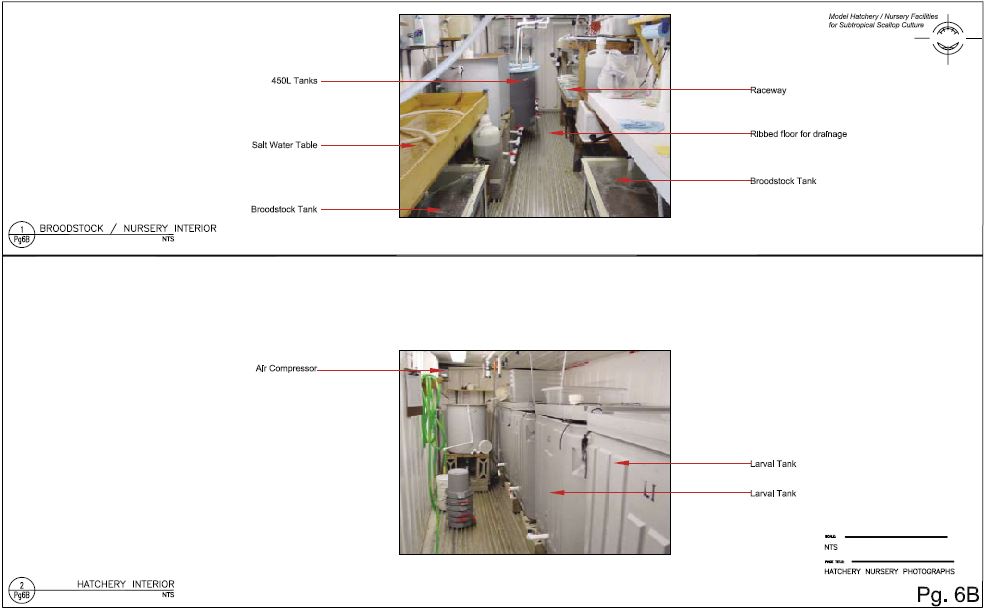
lines enter the far right corner of the container and are affixed to the ceiling by plastic clips. The installation of the plumbing on the ceiling is fundamental, as not only are the pipes out of the way but safety is ensured within the facility. Both lines run down the middle of the whole complex, supplying all tanks. A typical filtration system is shown at the right hand corner of the broodstock/nursery container for filtration of ambient seawater to 1 µm, available to all tanks except broodstock tanks. A 220 litres sump tank, used in conjunction with the raceways, is located next to the filtration system (see technical drawing – Page 14 for detail). Two 200x60x15 cm deep flow
troughs are mounted on a sidewall, one above the other, acting as raceways. This system is extremely versatile; each raceway can be used independently as an open, closed, or semi-recirculating system. This allows for setting of larvae on sieves, conducting experiments in a series of independent aquaria, or using both raceways as one larger system with a total capacity of 510 litres, in, for example, the early nursery culture of spat.
Two broodstock tanks are located on the exterior of the container, one below the bench area, and the other below the saltwater table. Finally, space is available for 450 litres nursery tanks, used for the setting of larvae, and rearing prior to the transfer at sea. A second air conditioning unit is located on the side of the broodstock/nursery container to maintain climate control. The air compressor is located at the far left on a shelf, supplying air to all tanks.
Two concrete gullies are located on the exterior of the complex to deliver waste seawater from the hatchery/nursery complex to drain pipes. Main drain pipes are constructed of 100 mm perforated pipe to receive excess seawater from various sources. Two drainage pipes run alongside the broodstock/nursery container receiving outflow from the broodstock tanks, saltwater table, the round nursery tanks, and raceway system.
1.1.4.3 Hatchery and nursery ceiling plan
Refer to Technical Drawing – Page 7. The ceiling plan for both the ambient and heated seawater lines in the complex, and for the air supply are shown. The ambient filtered seawater line is coded blue; the heated seawater line is coded in red, and the airline in green. The raw seawater supply to the broodstock is dotted in blue, and bypasses the filtration system. In the hatchery, valves controlling seawater supply are also colour coded with respect to the temperature of the water – red for heated seawater and blue for ambient. This colour coding ensures clarity for all users, and minimizes any technical error which may be detrimental to larval and post-larval cultures.
Heated and ambient seawater supply
Refer to Technical Drawing – 1/Pg7. The ambient seawater supply comes directly from the pump room, having passed through a sand filter before entering the hatchery/ nursery complex. A 50 mm pipe is affixed on the exterior of the container, and passes through the wall of the container, parallel to the heated seawater line. Inside the container, a 50 mm T (T14) diverts the water into: a) A typical filtration system (TFS), supplying filtered seawater to all hatchery/nursery tanks and saltwater table; and b) Broodstock tank 1, Broodstock tank 2 via junction T15. Note: Details for this main diversion junction (T14) are given in technical drawing – 1/Page 8.
After passing through the typical filtration system the 1 µm filtered ambient seawater is distributed to all tanks via junction T16. The main (1 µm filtered) seawater line is affixed to the ceiling in the middle of the container parallel to the heated seawater line (see technical drawing Photo – 4/Pg7). T-junctions are fitted in-line for diverting filtered seawater to the remaining separate tank units; such that in the first container (nursery/broodstock area), there are three T-junctions supplying ambient (and heated)
Technical drawing, Pg. 7
Hatchery & nursery: Ceiling plan
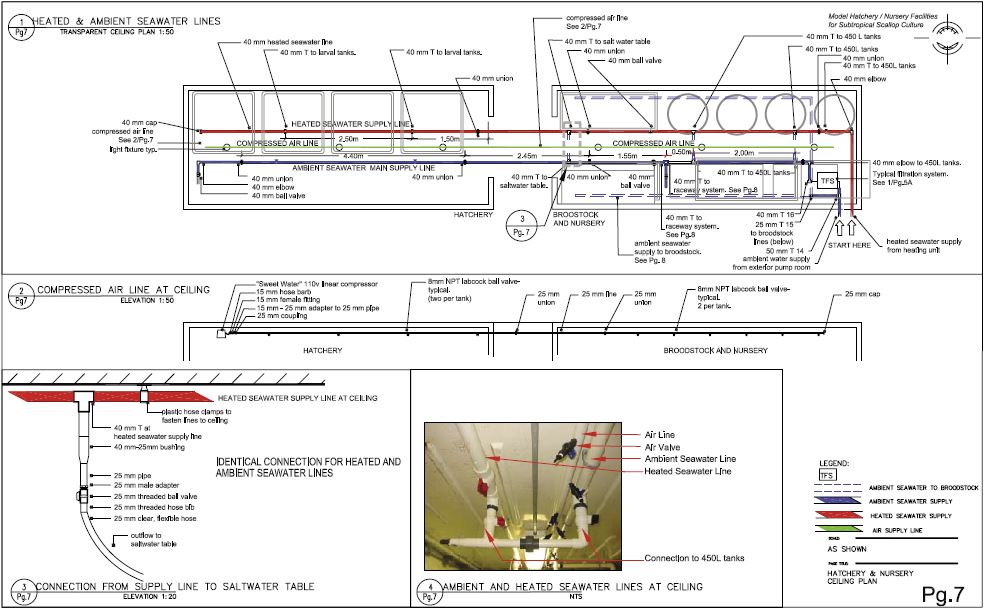
seawater to the circular 450 litres tanks, one T-junction supplying ambient seawater to the raceways, and one T-junction supplying ambient seawater to the saltwater table. One-way ball valves regulate the flow to various areas. Detail of the flow to the saltwater table is similar to that given for the heated seawater supply in technical drawing – 3/Pg7. Details of other junctions are given when appropriate in respective sections of the manual. In the second container, specific to larval rearing, there is less need for ambient seawater; hence there is only one ball valve at the end of the water line for supply of ambient seawater, if needed.
Heated seawater line
The heated seawater line supply coming directly from the heating shed runs parallel to the filtered ambient seawater line. T-junctions are similarly fitted in line to supply heated seawater to the separate tanks. In the first nursery/broodstock container, three T-junctions supply heated seawater to the 450 litres tanks, and one to the saltwater table. Connection to the saltwater table is described in technical drawing – 3/Pg7 and is installed parallel to that of ambient seawater. Similarly, details of connections to other tanks are provided in later sections of the manual. In the second hatchery container, two T-junctions supply heated seawater to 4 larval tanks (one junction for two tanks). The heated seawater line is capped at the end with a 40 mm cap.
Air supply
Refer to Technical Drawing – 2/Pg7. The line for compressed air runs the length of the complex, affixed to the ceiling and parallel to the ambient and heated seawater lines, as shown in the ceiling plan. The location of a small compressor on a shelf at one end of the complex is shown on the diagram. Air is supplied through a 25 mm pipe to larval, broodstock, experimental and raceway tanks. Outlets are placed frequently, and airflow is controlled by labcock ball valves, to which a male barb is fitted for connection to an appropriate length of Tygon tubing (7 mm ID) to the tanks.
Details of seawater supply to saltwater table
Refer to Technical Drawing – 3/Pg7. Once diverted through the 40 mm T-junction at the main line, reduction of the pipe to 25mm is done with a 40 mm to 25 mm bushings. A 25 mm male adapter fits into a 25 mm threaded ball valve, which in turn is fitted on the outflow end with a 25 mm threaded hose barb. A 25 mm clear flexible hose supplies water to the saltwater table when needed.
1.1.4.4 Broodstock: tank and seawater supply
Broodstock seawater supply details
Refer to Technical Drawing – page 8. Sand filtered ambient seawater line entering the complex from the exterior, first passes through junction T14, located at the point of entry of the seawater pipe into the container (Diagram 1/Pg8). Water flow is directed to the filtration system and/or to a reduced 25 mm junction T15 for supply to broodstock tanks. The point of entry of both ambient and heated seawater lines is illustrated and labelled on the technical drawing photo – 2/Pg8.
For fine filtration of the ambient seawater, flow coming from T14 is regulated by a 50 mm one-way ball valve to a coarse Hayward filter (25 µm). The 50 mm pipeline is reduced 40 mm prior to the filter for proper fittings. Unions after the valve and on either side of the filter allow for replacement of parts and cleaning of system. A 10 µm and 1 µm cartridge filter housings are installed in-line following the coarse filter as detailed in the typical filtration system (see technical drawing – 1/Pg5A). From the 1 µm filter, the seawater is distributed to the raceways, tanks, and saltwater table, by a 40 mm line connected to the centre of the container ceiling using plastic clamps. Water
Technical drawing, Pg. 8
Broodstock: Tank and seawater supply

is then distributed to all tanks, via junction T16 along the supply line located on the ceiling of the complex.
For supply to the broodstock tanks, ambient seawater diverted through T14 flows through T15. This directs the coarsely filtered seawater (from sand filter in pump house) to Broodstock tank 1 and Broodstock tank 2. The flow for these tanks is regulated by a 25 mm ball valve for each tank. Unions (25 mm) located prior to elbows facilitate the necessary dismantling of pipes for cleaning. A second 25 mm ball valve located prior to the inflow into the tank allows for refinement of flow rate.
Broodstock tank
Refer to Technical Drawing – page 8. The two broodstock tanks are identical, 380 litres in volume (120x50x60 cm) and made of fiberglass with a clear viewing window in the front. A Plexiglas lid prevented any debris falling from above. A sub-sand filtration system is installed as follows: 25 mm diameter supporters are cut in 50 mm length and spaced out on the bottom of the tank; these supported a Plexiglas sheet drilled with 8 mm holes every 50 mm. On top of the Plexiglas sheet, is a 500 µm Nitex mesh covering the entire surface. Finally a layer of sand, previously washed and passed through a 1 mm screen, covers the bottom of the tank. Each broodstock tank is set for a semi-recirculation system, thus maximizing the residence time of added food, and allowing for some control in seawater temperature. Ambient coarsely filtered seawater (via the sand filter in the pump house) is supplied by a 25 mm pipe, and inflow is regulated by a 25 mm one-way PVC ball valve at the end of the line. Seawater flows in at the top of the tank. The semi-recirculation system is driven by an air lift, consisting of a 20 mm pipe placed on the bottom of the tank, and connected to a vertical pipe via an elbow. The airline (7 mm Tygon tubing) is inserted into the pipe. A T-junction at the top of the pipe allows for recirculated water to flow back into the tank. Outflow is achieved at the surface of the water, via a thru-hull fitting and hose discharging through the container wall and into the main drain pipes outside.
At certain times, during broodstock conditioning, temperature of seawater needs to be adjusted. Seawater within each tank can be cooled using a 1/5 HP chiller unit installed on a nearby shelf. The chiller is matched in size with the capacity of the tanks to allow for cooling through a 5 °C differential from ambient seawater temperature. For heating the ambient seawater, 250 Watts Ebo-Jaeger aquarium heaters were immersed in the tank; with a flow of 40 litres.h-1, two 250 Watt heaters are sufficient to heat the water 5 °C above that of ambient.
Feeding of broodstock is done using one 20-litre carboy for each tank. Carboys are purchased with an existing spigot, located at the bottom of the carboy. This spigot is fitted with a stopcock valve and 7 mm tubing for a finer adjustment of algal flow to the tank. A fast drip-feed is usually adequate to supply algae from one carboy over 24 hours.